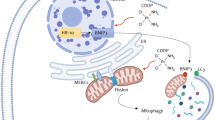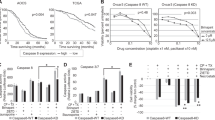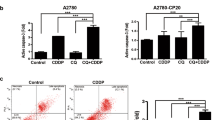Abstract
XK469, a synthetic quinoxaline phenoxypropionic acid derivative, has been found to have selective activity against a broad panel of solid tumors including several drug-resistant cell lines and has been approved for phase I clinical evaluation. Recent studies suggested that XK469 is a selective topoisomerase IIβ inhibitor, but the mechanism of XK469-induced cell death remains unknown. Here we investigate the ability of XK469 to induce apoptosis of human cancer cells. In the human ovarian cancer cell line PA1, XK469 caused the release of cytochrome c, activation of caspases including caspases 9, 7 and 3, cleavage of PARP, and subsequently cell death. Moreover, Bcl2 and Bax were cleaved in XK469 treated cells. PA1 cells expressing the dominant negative-caspase 9 were less sensitive to XK469. Importantly, in these PA1 cells expressing DN-casp 9, the activation of caspases including caspases 3, 7 and 9, and cleavage of Bax and Bcl2 were inhibited, suggesting that the activation of the mitochondrial pathway is required for XK469-induced anticancer activity. These results indicate that the induction of apoptosis by XK469 may account for its anti-tumor activity and such activity is required for the activation of the mitochondrial pathway. Thus, our study defines a possible mechanism, at least in part, underlying XK469-induced anti-cancer activity.
This is a preview of subscription content, access via your institution
Access options
Subscribe to this journal
Receive 50 print issues and online access
$259.00 per year
only $5.18 per issue
Buy this article
- Purchase on Springer Link
- Instant access to full article PDF
Prices may be subject to local taxes which are calculated during checkout




Similar content being viewed by others
References
Adams JM, Cory S . 1998 Science 281: 1322–1326
Alnemri ES, Livingston DJ, Nicholson DW, Salvesen G, Thornberry NA, Wong WW, Yuan J . 1996 Cell 87: 171–
Blagosklonny MV, Chuman Y, Bergan RC, Fojo T . 1999 Leukemia 13: 1028–1036
Blagosklonny MV, Schulte T, Nguyen P, Trepel J, Neckers LM . 1996 Cancer Res. 56: 1851–1854
Chen Q, Gong B, Almasan A . 2000 Cell Death Differ. 7: 227–233
Chen Q, Gong B, Mahmoud-Ahmed AS, Zhou A, Hsi ED, Hussein M, Almasan A . 2001 Blood 98: 2183–2192
Cheng EH, Kirsch DG, Clem RJ, Ravi R, Kastan MB, Bedi A, Ueno K, Hardwick JM . 1997 Science 278: 1966–1968
Corbett TH, LoRusso P, Demchick L, Simpson C, Pugh S, White K, Kushner J, Polin L, Meyer J, Czarnecki J, Heilbrun L, Horwitz JP, Gross JL, Behrens CH, Harrison BA, McRipley RJ, Trainor G . 1998 Invest New Drugs 16: 129–139
Costantini P, Jacotot E, Decaudin D, Kroemer G . 2000 J. Natl. Cancer Inst. 92: 1042–1053
Cryns V, Yuan J . 1998 Genes Dev. 12: 1551–1570
Ding Z, Parchment RE, LoRusso PM, Zhou J-Y, Li J, Lawrence TS, Sun Y, Wu GS . 2001 Clin. Cancer Res. 7: 3336–3342
Gao G, Dou QP . 2000 J. Cell. Biochem. 80: 53–72
Gao H, Huang KC, Yamasaki EF, Chan KK, Chohan L, Snapka RM . 1999 Proc. Natl. Acad. Sci. USA 96: 12168–12173
Green DR . 1998 Cell 94: 695–698
Gross A, McDonnell JM, Korsmeyer SJ . 1999 Genes Dev. 13: 1899–1911
Hsu YT, Wolter KG, Youle RJ . 1997 Proc. Natl. Acad. Sci. USA 94: 3668–3672
Juin P, Hueber AO, Littlewood T, Evan G . 1999 Genes Dev. 13: 1367–1381
Kirsch DG, Doseff A, Chau BN, Lim DS, de Souza-Pinto NC, Hansford R, Kastan MB, Lazebnik YA, Hardwick JM . 1999 J. Biol. Chem. 274: 21155–21161
Kluck RM, Bossy-Wetzel E, Green DR, Newmeyer DD . 1997 Science 275: 1132–1136
Korsmeyer SJ . 1999 Cancer Res. 59: 1693S–1700S
Li H, Zhu H, Xu CJ, Yuan J . 1998 Cell 94: 491–501
Li P, Nijhawan D, Budihardjo I, Srinivasula SM, Ahmad M, Alnemri ES, Wang X . 1997 Cell 91: 479–489
LoRusso PM, Parchment R, Demchik L, Knight J, Polin L, Dzubow J, Behrens C, Harrison B, Trainor G, Corbett TH . 1998 Invest New Drugs 16: 287–296
Luo X, Budihardjo I, Zou H, Slaughter C, Wang X . 1998 Cell 94: 481–490
Rosse T, Olivier R, Monney L, Rager M, Conus S, Fellay I, Jansen B, Borner C . 1998 Nature 391: 496–499
Snapka RM, Gao H, Grabowski DR, Brill D, Chan KK, Li L, Li GC, Ganapathi R . 2001 Biochem. Biophys. Res. Commun. 280: 1155–1160
Srinivasula SM, Ahmad M, Fernandes-Alnemri T, Alnemri ES . 1998 Mol. Cell 1: 949–957
Sun SY, Yue P, Zhou J-Y, Wang Y, Kim HC, Lotan R, Wu GS . 2001 Biochem. Biophys. Res. Commun. 280: 788–797
Vander Heiden MG, Chandel NS, Williamson EK, Schumacker PT, Thompson CB . 1997 Cell 91: 627–637
Wang KK . 2000 Trends Neurosci. 23: 20–26
Wood DE, Newcomb EW . 2000 Exp. Cell Res. 256: 375–382
Wu GS, Burns TF, McDonald ER, Meng RD, Kao G, Muschel R, Yen T, El-Deiry WS . 1999 Oncogene 18: 6411–6418
Wu GS, Ding Z . 2002 Oncogene 21: 1–8
Wu GS, El-Deiry WS . 1996 Clin. Cancer Res. 2: 623–633
Yang J, Liu X, Bhalla K, Kim CN, Ibrado AM, Cai J, Peng TI, Jones DP, Wang X . 1997 Science 275: 1129–1132
Acknowledgements
This work was supported by a start-up fund and a Virtual Discovery Grant from the Karmanos Cancer Institute (GS Wu).
Author information
Authors and Affiliations
Corresponding author
Rights and permissions
About this article
Cite this article
Ding, Z., Zhou, JY., Wei, WZ. et al. Induction of apoptosis by the new anticancer drug XK469 in human ovarian cancer cell lines. Oncogene 21, 4530–4538 (2002). https://doi.org/10.1038/sj.onc.1205545
Received:
Revised:
Accepted:
Published:
Issue Date:
DOI: https://doi.org/10.1038/sj.onc.1205545



